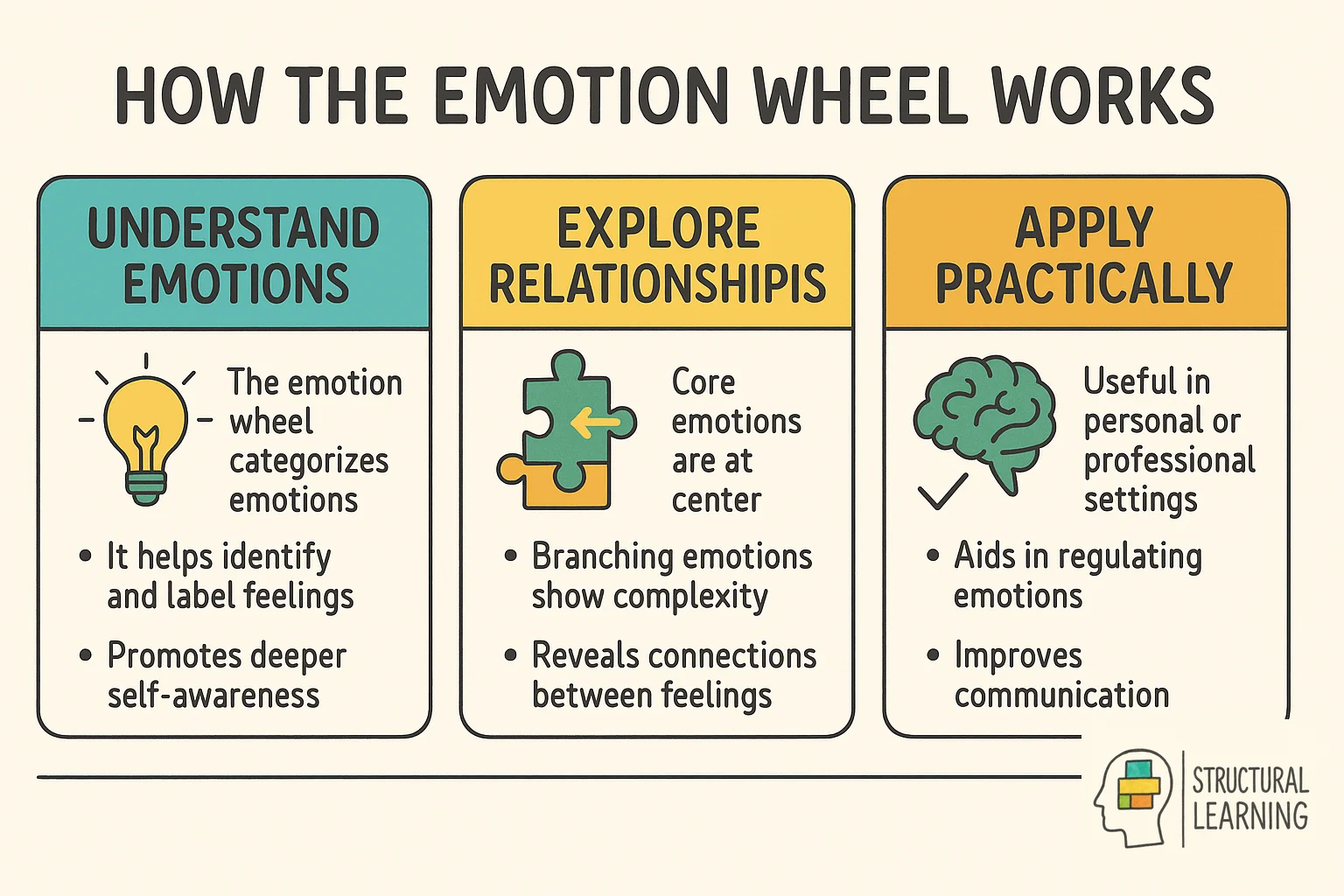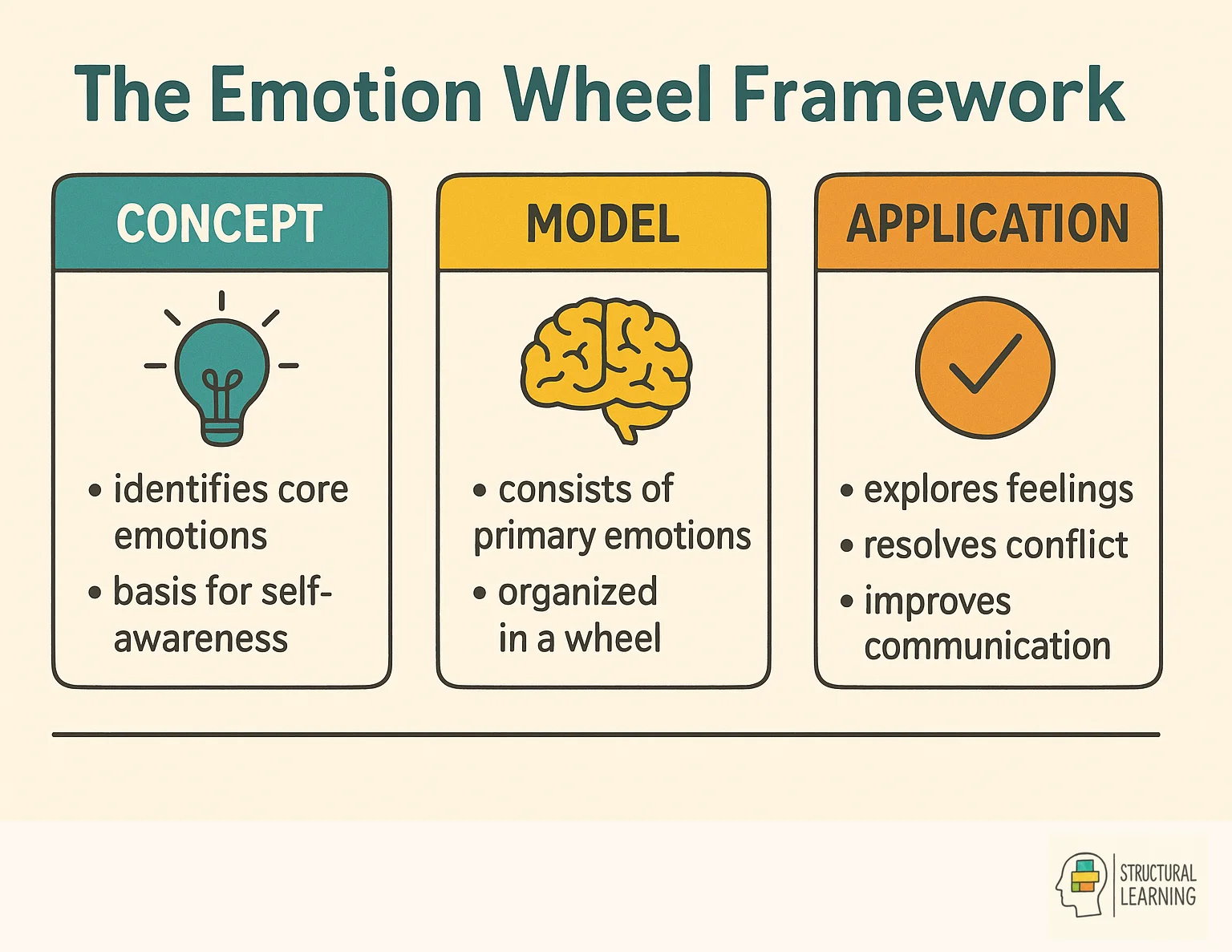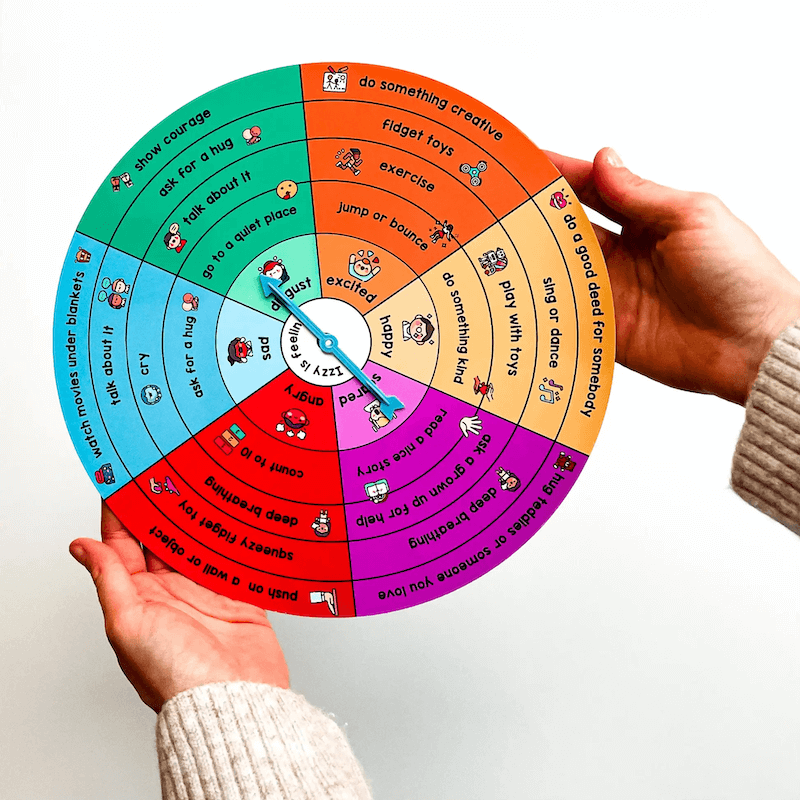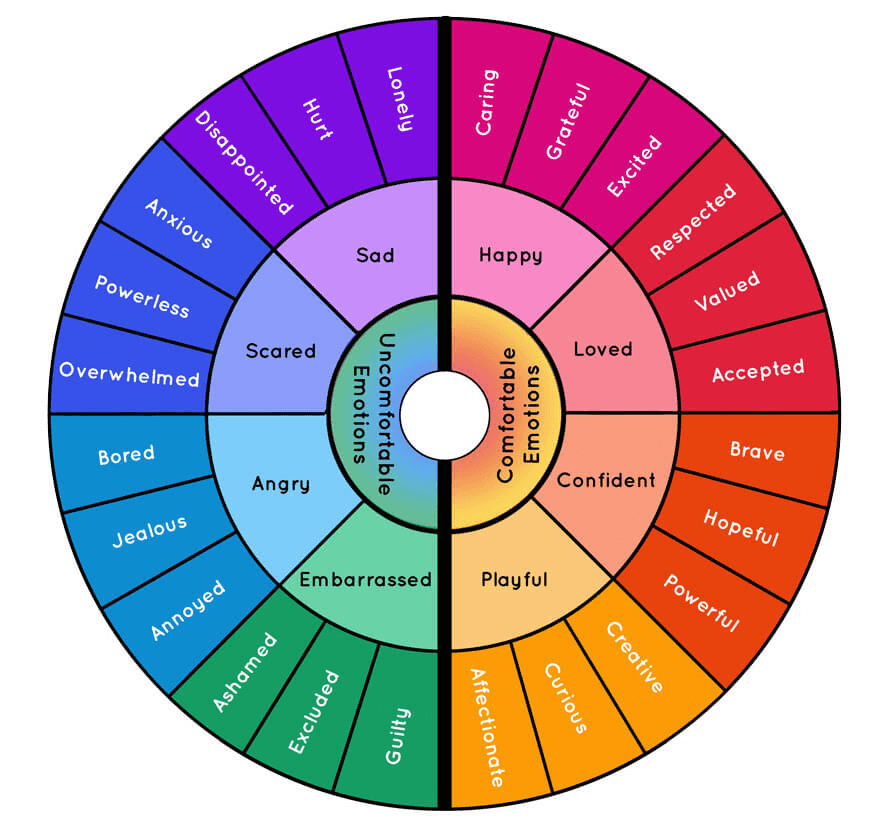Emotion Wheel
Learn how the emotion wheel enhances emotional literacy and student wellbeing through practical classroom applications and proven research-backed strategies.


The Emotion Wheel helps people spot and understand their feelings. This circular tool shows the full range of human emotions in a clear, visual way.
The wheel has primary emotions at its centre. These include joy, anger, sadness, fear, surprise, and disgust. Around these core feelings are different shades and levels of intensity. This shows how emotions can be mild or strong.

The most famous version is the Plutchik Wheel. It has eight primary emotions: joy, sadness, anger, fear, trust, surprise, anticipation, and disgust. Each emotion pairs with another to create new feelings. For example, joy and trust combine to make love. Sadness and disgust create remorse.
Students can use this tool to name their feelings more clearly. It helps build emotional intelligence, develops critical thinking, supports self-regulation, and improves how they talk about their inner world, and enhances student motivation.

Robert Plutchik created the emotion wheel in his book 'Emotion: a Psychoevolutionary Synthesis'. His work changed how we think about feelings and their role in human behaviour.
Plutchik found eight basic emotions that all humans share. These are joy, sadness, anger, fear, trust, disgust, surprise, and anticipation. He believed these emotions helped our ancestors survive. They form the building blocks for all other feelings we experience.
The emotion wheel shows these emotions and how they connect. Plutchik discovered that emotions can blend together like colours on an artist's palette. Joy and trust create love. Anticipation and fear produce anxiety. This mixing creates the rich emotional life humans experience.
Psychologists, therapists, and teachers now use the emotion wheel worldwide. It helps people understand their feelings better and build emotional intelligence. The wheel continues to evolve as researchers add new insights.

The Emotion Wheel has a simple but powerful design. Eight primary emotions sit at the centre: joy, trust, fear, surprise, sadness, disgust, anger, and anticipation.
Each primary emotion spreads outward into 16 different levels of intensity. This means students can pinpoint exactly how strong their feeling is. They might feel mildly annoyed or absolutely furious, both forms of anger.
Colours make the wheel easy to understand. Dark shades show intense emotions. Light shades represent gentler feelings. Students can quickly see where their emotions fit on the intensity scale.
The wheel also shows dyad combinations between emotions. These appear outside the main flower shape. They represent behaviours that come from mixing two emotions together.

Emotional literacy means knowing how to spot, understand, and manage feelings. Both your own emotions and other people's emotions matter. Schools that teach these skills see amazing results.
1. Students learn to control their emotions better. When pupils can manage their feelings, they focus more in class. They cope with stress and bounce back from setbacks. This emotional control helps them learn and grow.
2. Emotional literacy builds empathy between classmates. Students understand how others feel and respond with kindness. This creates stronger friendships and reduces bullying. The whole school becomes more caring and supportive.
3. Communication skills improve when students understand emotions. They listen more carefully and pick up on body language. They express themselves more clearly too. These skills help in group work and solving disagreements.
4. Healthy relationships develop more easily. Students who understand emotions build trust with others. They communicate openly and respect different viewpoints. This makes the classroom a happy place to learn.
5. Personal growth speeds up with emotional awareness. Students learn about their strengths and weaknesses. They make better choices and work towards their goals. Emotional literacy gives them tools for lifelong success.
These examples show how the emotion wheel works in real classrooms. Students move from basic feelings to more complex emotions. This helps them understand themselves better.

The Emotion Wheel gives students the words they need to describe their feelings accurately. This helps them understand what's happening inside their minds and hearts. When pupils can name their emotions, they gain power over them.
Therapists and counsellors find the wheel particularly helpful. Clients can point to emotions they struggle to explain in words. This makes sessions more productive and helps people understand their emotional patterns better.
The wheel also teaches emotional regulation. Students learn to spot their feelings early, before they become overwhelming. They can then choose how to respond rather than just reacting automatically.
Mental health improves when people use tools like the emotion wheel. Students feel more in control of their emotions. They make better decisions and build stronger relationships.

1. Start by helping students find their primary emotions. The wheel has three main groups with secondary emotions branching out. Students learn to spot the root cause of how they feel.
2. Explore the subtle differences between similar emotions. Each primary emotion connects to many specific feelings. Students expand their emotional vocabulary and understand themselves better.
3. Track emotional patterns over time. Students can use the wheel like a map to see which emotions come up often. They spot triggers and learn about their emotional habits.
4. Add the emotion wheel to journal writing. Students can look at the wheel while writing about their day. They find better words to describe their experiences and feelings.
5. Use the wheel to understand others better. Students practice spotting emotions in classmates and characters in stories. This builds empathy and social skills.
6. Practice managing difficult emotions. When students can name their feelings using the wheel, they can choose better ways to cope. Different emotions need different strategies.
7. Lead group discussions about emotions. The wheel gives everyone a common language to talk about feelings. Students feel safer sharing when they have clear words to use.

The emotion wheel has changed how we understand and manage mental health. This colourful tool helps people navigate their emotional world more easily.
Mental health improves when people can identify their emotions accurately. The wheel shows the full range of human feelings, from basic to complex. Students learn that all emotions are normal and temporary.
The wheel teaches emotional intelligence by giving structure to confusing feelings. Students can point to their current emotional state and understand what they're experiencing. This awareness is the first step towards better mental health.
In therapy sessions, the emotion wheel becomes a bridge between feelings and words. Therapists use it to help clients express emotions they couldn't describe before. It also helps people track their emotional patterns over time.
Students learn healthy ways to cope with different emotions. The wheel doesn't judge any feeling as good or bad. Instead, it helps people understand what each emotion means and how to respond helpfully.

Studies prove that understanding emotions improves learning outcomes. These research findings show why tools like the emotion wheel matter in schools.
The Emotion Wheel helps people spot and understand their feelings. This circular tool shows the full range of human emotions in a clear, visual way.
The wheel has primary emotions at its centre. These include joy, anger, sadness, fear, surprise, and disgust. Around these core feelings are different shades and levels of intensity. This shows how emotions can be mild or strong.

The most famous version is the Plutchik Wheel. It has eight primary emotions: joy, sadness, anger, fear, trust, surprise, anticipation, and disgust. Each emotion pairs with another to create new feelings. For example, joy and trust combine to make love. Sadness and disgust create remorse.
Students can use this tool to name their feelings more clearly. It helps build emotional intelligence, develops critical thinking, supports self-regulation, and improves how they talk about their inner world, and enhances student motivation.

Robert Plutchik created the emotion wheel in his book 'Emotion: a Psychoevolutionary Synthesis'. His work changed how we think about feelings and their role in human behaviour.
Plutchik found eight basic emotions that all humans share. These are joy, sadness, anger, fear, trust, disgust, surprise, and anticipation. He believed these emotions helped our ancestors survive. They form the building blocks for all other feelings we experience.
The emotion wheel shows these emotions and how they connect. Plutchik discovered that emotions can blend together like colours on an artist's palette. Joy and trust create love. Anticipation and fear produce anxiety. This mixing creates the rich emotional life humans experience.
Psychologists, therapists, and teachers now use the emotion wheel worldwide. It helps people understand their feelings better and build emotional intelligence. The wheel continues to evolve as researchers add new insights.

The Emotion Wheel has a simple but powerful design. Eight primary emotions sit at the centre: joy, trust, fear, surprise, sadness, disgust, anger, and anticipation.
Each primary emotion spreads outward into 16 different levels of intensity. This means students can pinpoint exactly how strong their feeling is. They might feel mildly annoyed or absolutely furious, both forms of anger.
Colours make the wheel easy to understand. Dark shades show intense emotions. Light shades represent gentler feelings. Students can quickly see where their emotions fit on the intensity scale.
The wheel also shows dyad combinations between emotions. These appear outside the main flower shape. They represent behaviours that come from mixing two emotions together.

Emotional literacy means knowing how to spot, understand, and manage feelings. Both your own emotions and other people's emotions matter. Schools that teach these skills see amazing results.
1. Students learn to control their emotions better. When pupils can manage their feelings, they focus more in class. They cope with stress and bounce back from setbacks. This emotional control helps them learn and grow.
2. Emotional literacy builds empathy between classmates. Students understand how others feel and respond with kindness. This creates stronger friendships and reduces bullying. The whole school becomes more caring and supportive.
3. Communication skills improve when students understand emotions. They listen more carefully and pick up on body language. They express themselves more clearly too. These skills help in group work and solving disagreements.
4. Healthy relationships develop more easily. Students who understand emotions build trust with others. They communicate openly and respect different viewpoints. This makes the classroom a happy place to learn.
5. Personal growth speeds up with emotional awareness. Students learn about their strengths and weaknesses. They make better choices and work towards their goals. Emotional literacy gives them tools for lifelong success.
These examples show how the emotion wheel works in real classrooms. Students move from basic feelings to more complex emotions. This helps them understand themselves better.

The Emotion Wheel gives students the words they need to describe their feelings accurately. This helps them understand what's happening inside their minds and hearts. When pupils can name their emotions, they gain power over them.
Therapists and counsellors find the wheel particularly helpful. Clients can point to emotions they struggle to explain in words. This makes sessions more productive and helps people understand their emotional patterns better.
The wheel also teaches emotional regulation. Students learn to spot their feelings early, before they become overwhelming. They can then choose how to respond rather than just reacting automatically.
Mental health improves when people use tools like the emotion wheel. Students feel more in control of their emotions. They make better decisions and build stronger relationships.

1. Start by helping students find their primary emotions. The wheel has three main groups with secondary emotions branching out. Students learn to spot the root cause of how they feel.
2. Explore the subtle differences between similar emotions. Each primary emotion connects to many specific feelings. Students expand their emotional vocabulary and understand themselves better.
3. Track emotional patterns over time. Students can use the wheel like a map to see which emotions come up often. They spot triggers and learn about their emotional habits.
4. Add the emotion wheel to journal writing. Students can look at the wheel while writing about their day. They find better words to describe their experiences and feelings.
5. Use the wheel to understand others better. Students practice spotting emotions in classmates and characters in stories. This builds empathy and social skills.
6. Practice managing difficult emotions. When students can name their feelings using the wheel, they can choose better ways to cope. Different emotions need different strategies.
7. Lead group discussions about emotions. The wheel gives everyone a common language to talk about feelings. Students feel safer sharing when they have clear words to use.

The emotion wheel has changed how we understand and manage mental health. This colourful tool helps people navigate their emotional world more easily.
Mental health improves when people can identify their emotions accurately. The wheel shows the full range of human feelings, from basic to complex. Students learn that all emotions are normal and temporary.
The wheel teaches emotional intelligence by giving structure to confusing feelings. Students can point to their current emotional state and understand what they're experiencing. This awareness is the first step towards better mental health.
In therapy sessions, the emotion wheel becomes a bridge between feelings and words. Therapists use it to help clients express emotions they couldn't describe before. It also helps people track their emotional patterns over time.
Students learn healthy ways to cope with different emotions. The wheel doesn't judge any feeling as good or bad. Instead, it helps people understand what each emotion means and how to respond helpfully.

Studies prove that understanding emotions improves learning outcomes. These research findings show why tools like the emotion wheel matter in schools.